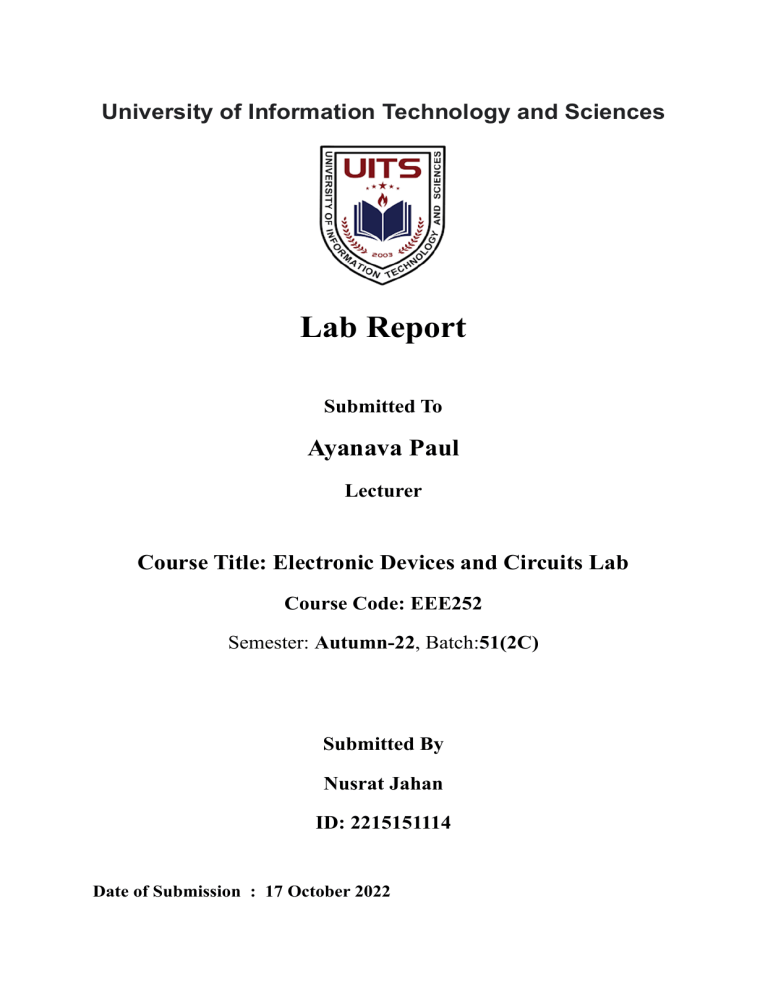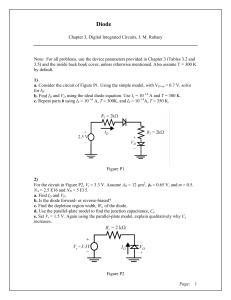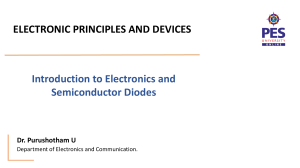
University of Information Technology and Sciences Lab Report Submitted To Ayanava Paul Lecturer Course Title: Electronic Devices and Circuits Lab Course Code: EEE252 Semester: Autumn-22, Batch:51(2C) Submitted By Nusrat Jahan ID: 2215151114 Date of Submission : 17 October 2022 Experiment No: 01 Experiment Name: Determination of the characteristic curve of a Diode. Theory: It is the simplest of semiconductor devices but plays a very vital role in electronic systems, having characteristics that closely match those of a simple switch. The ideal diode is a two-terminal device formed from a junction of n-type and p-type semiconductor material. The lead connected to the p-type material is called the anode and the lead connected to the n-type material is the cathode. In general, the cathode of a diode is marked by a solid line on the diode. It has low (ideally zero) resistance to the flow of current in one direction, and high (ideally infinite) resistance in the other direction. A diode is made of a crystal of semiconductor, usually silicon, but germanium and gallium arsenide are also used. Impurities are added to it to create a region on one side that contains negative charge carriers (electrons), called an n-type semiconductor, and a region on the other side that contains positive charge carriers (holes), called a p-type semiconductor. P-type of semiconducting material is made by defusing impurity of trivalent type of material in the pure form of semiconductor.N-type semiconducting material is made by defusing impurity of pentavalent type of material in the pure form of semiconductor. When the n-type and p-type materials are attached together, a momentary flow of electrons occur from the n to the p side resulting in a third region between the two where no charge carriers are present. This region is called the depletion region because there are no charge carriers (neither electrons nor holes) in it. The diode's terminals are attached to the n-regions and p-regions. The boundary between these two regions, called a p–n junction, is where the action of the diode takes place. When the diode is forward biased, due to the negative terminal on the n-side, electrons from the n-side are pushed towards the p-region. Similarly, due to positive voltage on the p-side of the diode, Holes from the p-region are pushed towards n-side. Due to this the electrons will start converting the positive ions in the p-region into neutral atoms and holes will start converting the negative ions in the n-region to neutral atoms. Hence width of the depletion region starts reducing due to reduction in the barrier potential. This keeps happening and at a certain point the depletion region collapses and there is no opposition to the flow of current. Hence large number of electrons and holes will cross the junction and make the current to flow from anode to cathode. Hence, forward biased electrical resistance of diode is very small and hence there is a small voltage drop (Practical condition, ideally there should be 0 forward resistance) across it. Its value for silicon diode is about 0.7 V. Thus, the p-n junction diode will allow a current to pass through it only when it is forward biased. When the diode is reversed biased the hole from the p-side will get attracted towards the negative terminal of the supply and electrons from the n-side are attracted towards the positive terminal. Hence the process of widening of the depletion region takes place and hence more and more opposition to the flow of current takes place. Hence, ideally the reverse biased resistance of the diode is infinite and no current flows from the diode when it is reversed biased. Due to large reverse biased voltage, suddenly large current will flow through the reverse biased voltage. Due to this large power gets dissipated in the diode which may damage it permanently. In zero bias condition no voltage is applied and no current flows through the diode. So, the diode remains in the cut-off region. Operation of diode can be summarized in form of ID-V diode characteristics graph. Circuit Diagram: Figure 1: Circuit Diagram of the experiment. Data Table: Data table for Diode Characteristic: V VD ID 0.300V 0.300V 0.0mA 0.400V 0.395V 0.0mA 0.500V 0.455V 0.0452mA 0.600V 0.480V 0.12mA 0.700V 0.494V 0.206mA Graph: Figure 2: ID-V characteristics in diode. Discussion: 1. We used create circuit in TinkerCAD and then simulate our circuit, and observed the voltage drop accross the diode,as well as the current through the diode. 2. We put the diode in forward bias and used a variable DC power supply to vary the supplied voltage, V 3. We varied the voltage from 0.3 to 0.7 volts. 4. We get ID and VD from the data table. 5. We put both ID and VD into the graph. 6. The graph shows that the curve goes up from the 0.5 volts. 7. The line gradually moves straight along the direction of ID when the value of VD is 0.7 volts.




